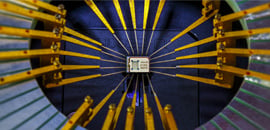Introduction
Celera Motion’s MicroE Optical Encoders offer standard hubs for each of our standard gratings. Should a customer want to design a hub themselves, these guidelines describe the key factors to incorporate into the design.
Once the hub design has been completed, we recommend that the hub drawing be sent to the MicroE Applications Engineering group for review.
After the hub has been manufactured, it can be sent to MicroE to have the grating mounted. The customer can also mount the grating to the hub themselves. However, if the grating is not mounted correctly to the hub, the accuracy of the encoder system will be compromised. The “Alignment of Rotary Scales” Tech Note provides for further information on mounting rotary gratings.
Exploded View of Hub, Grating, and Mounting Clamp















